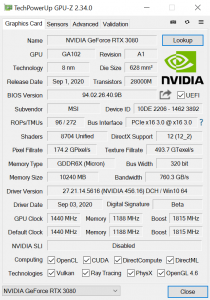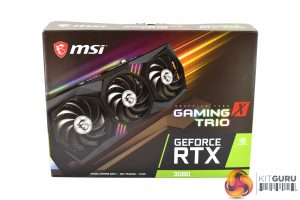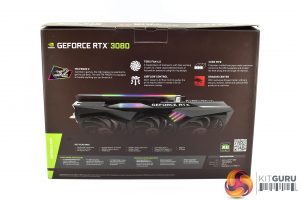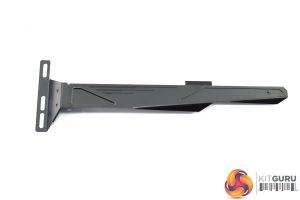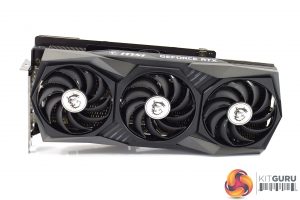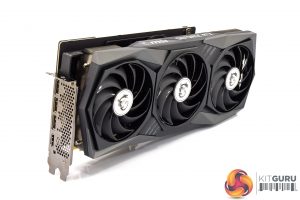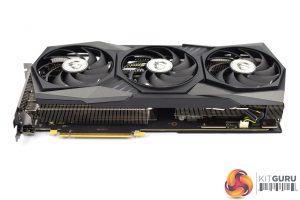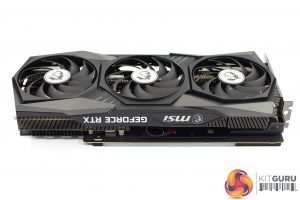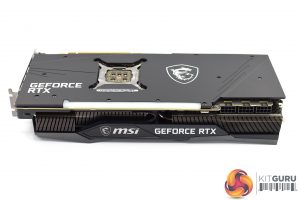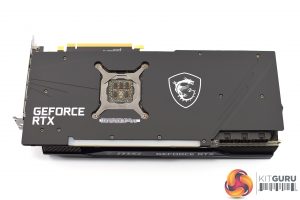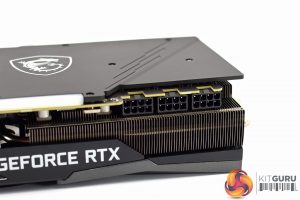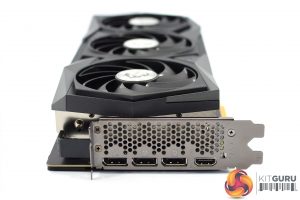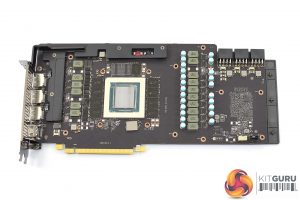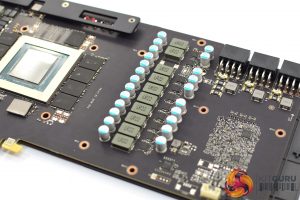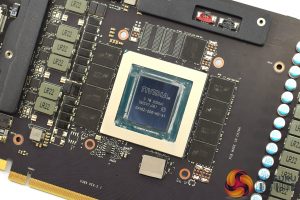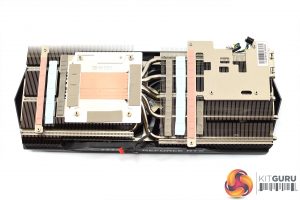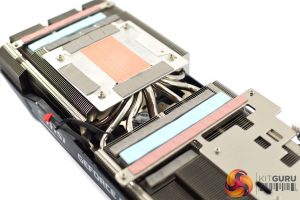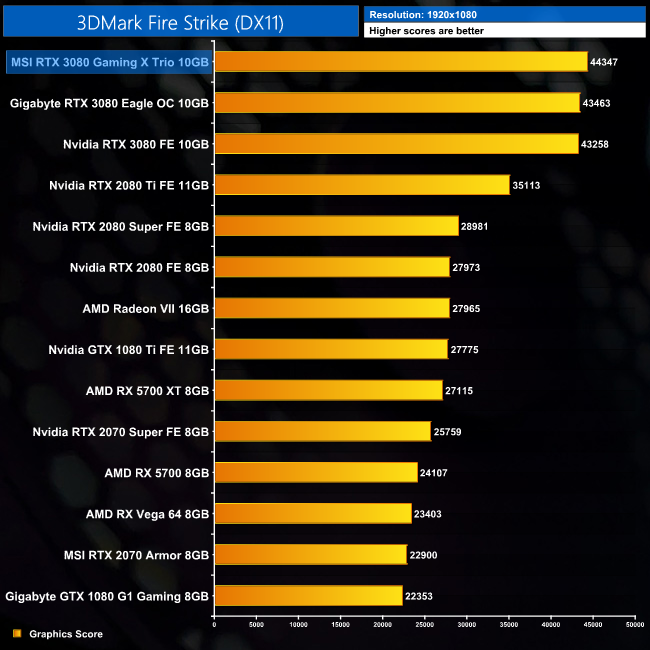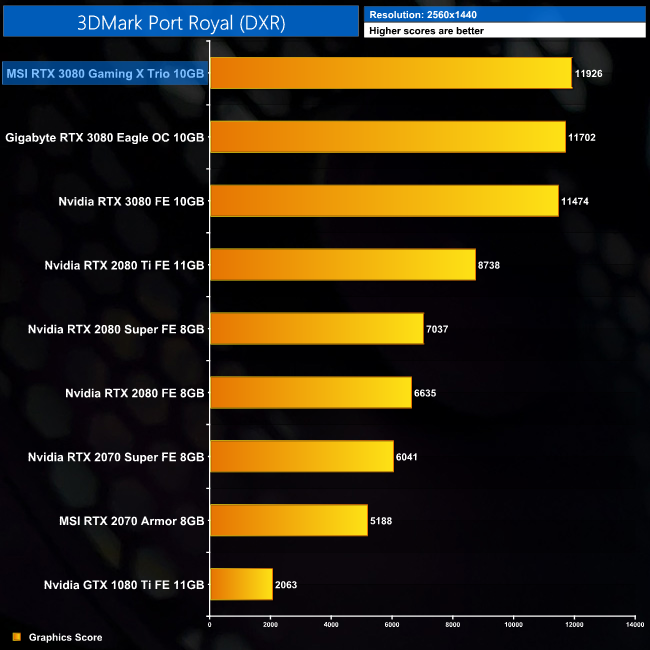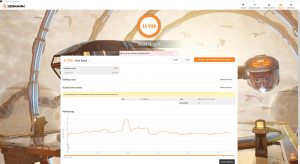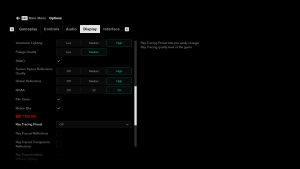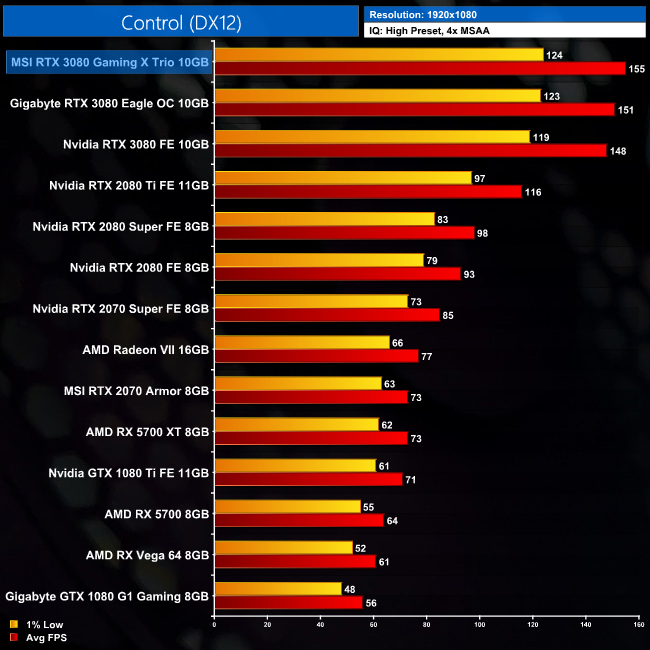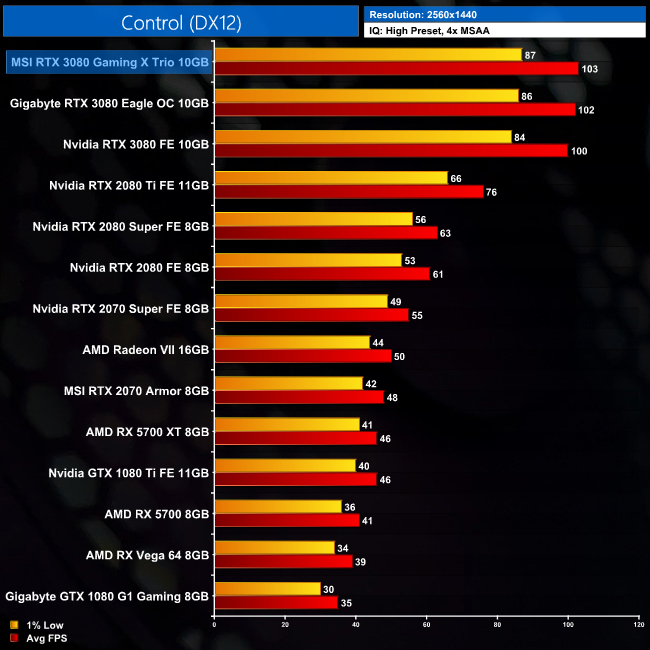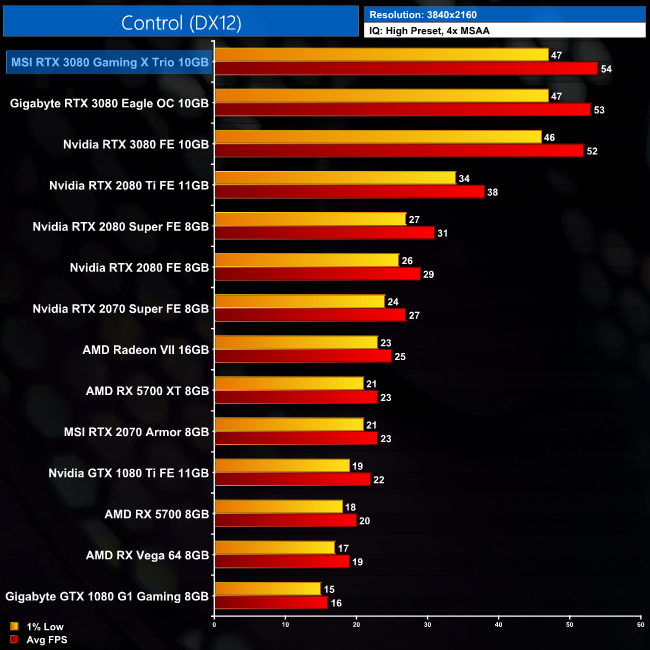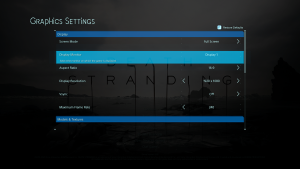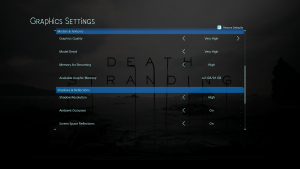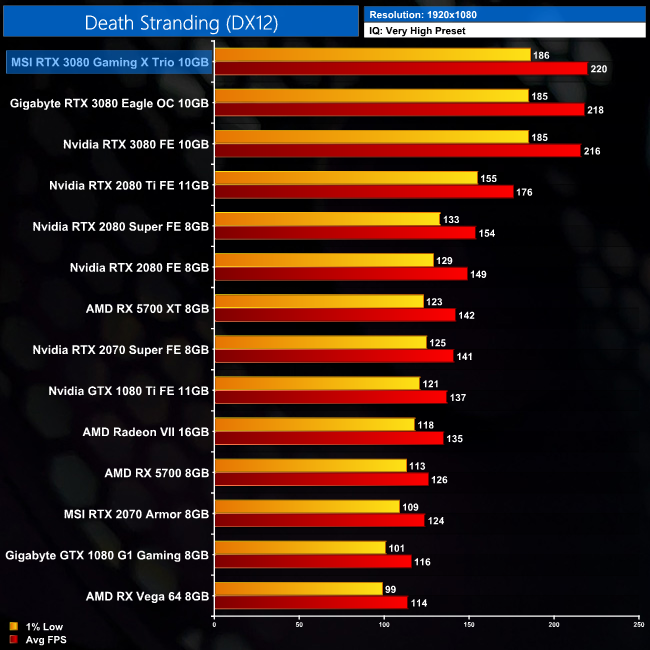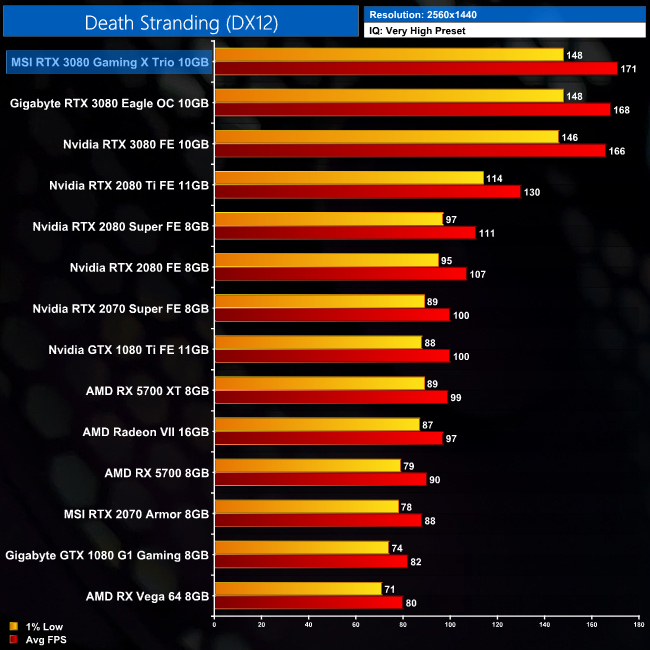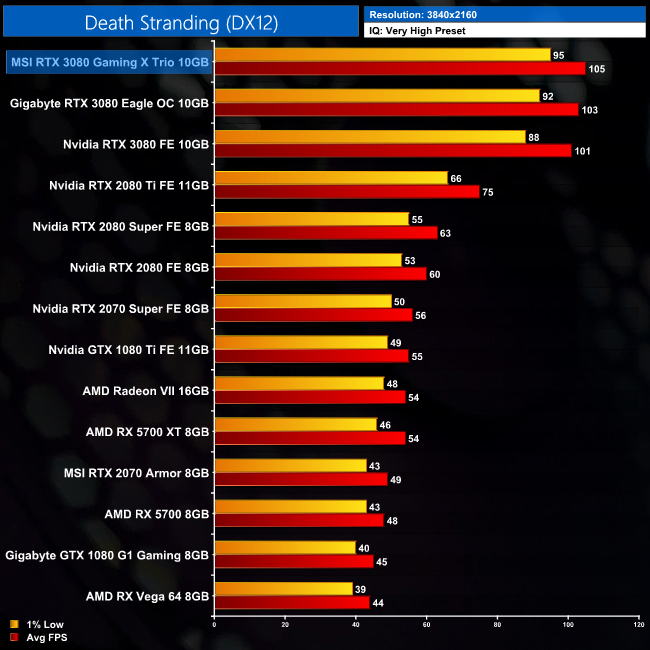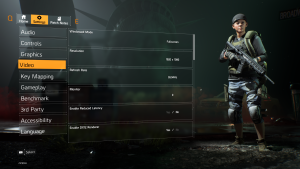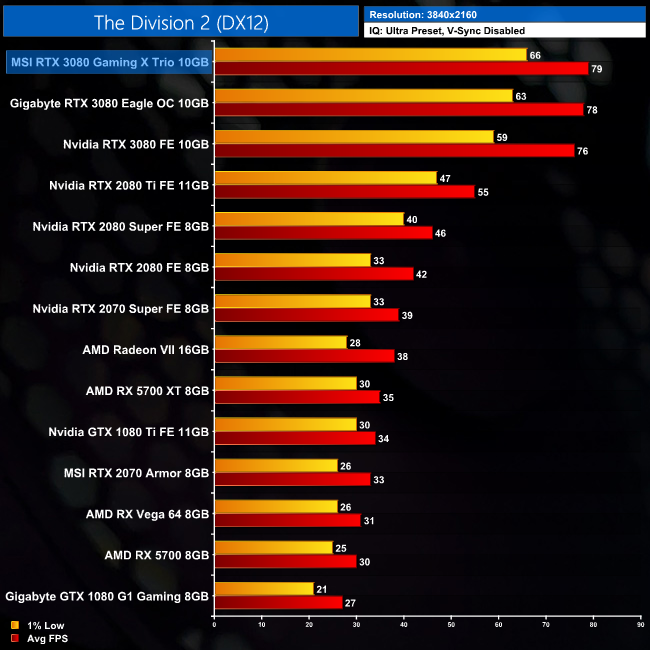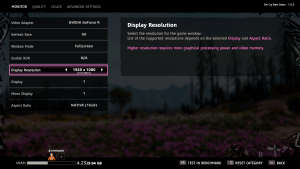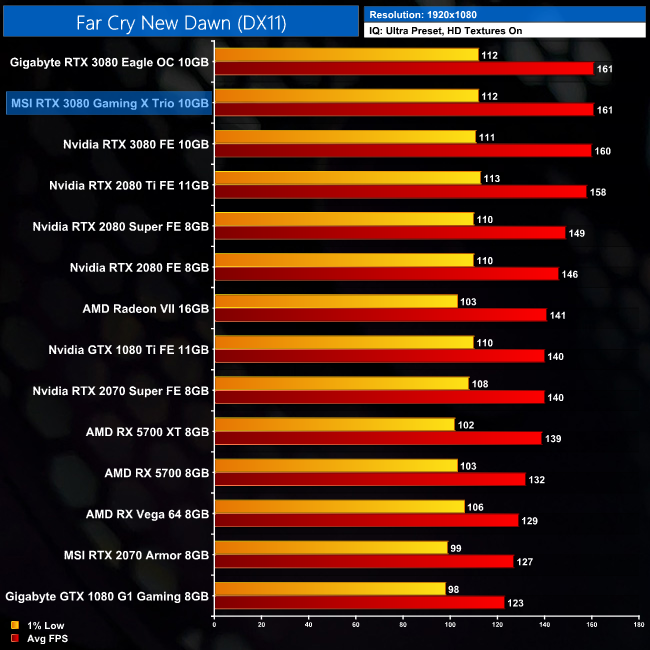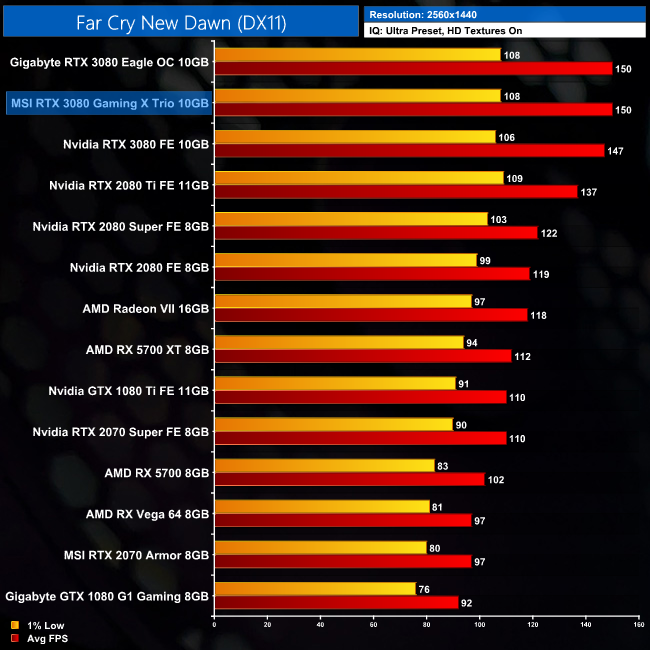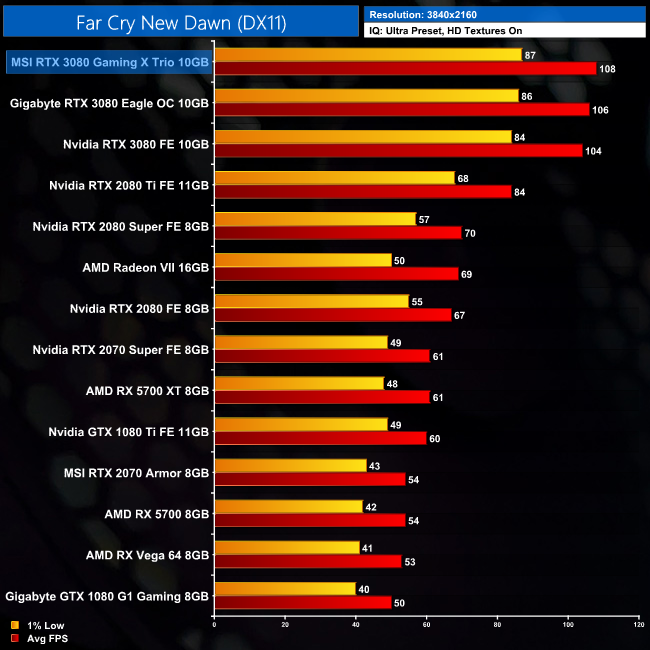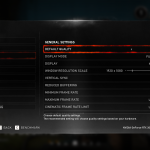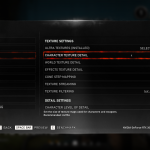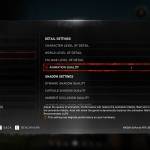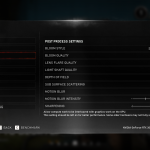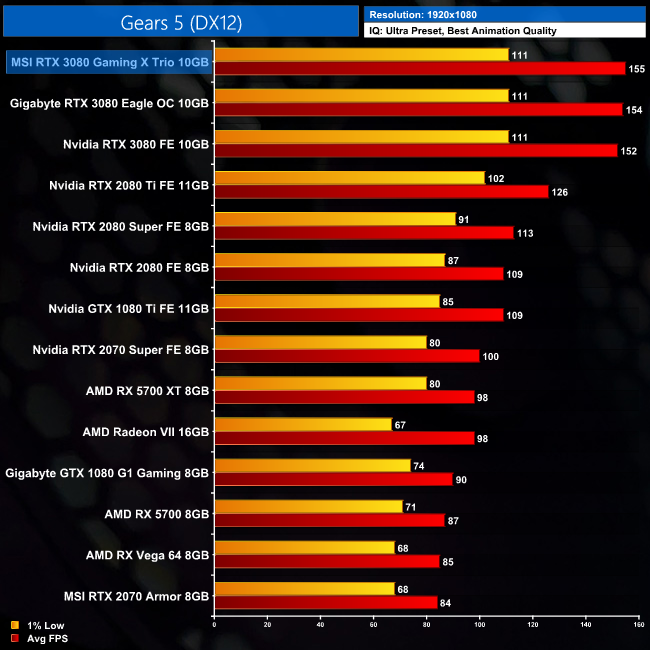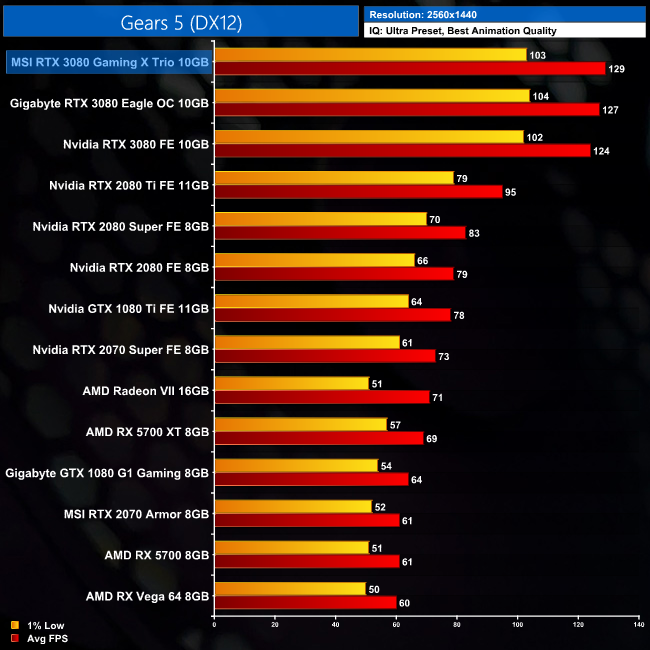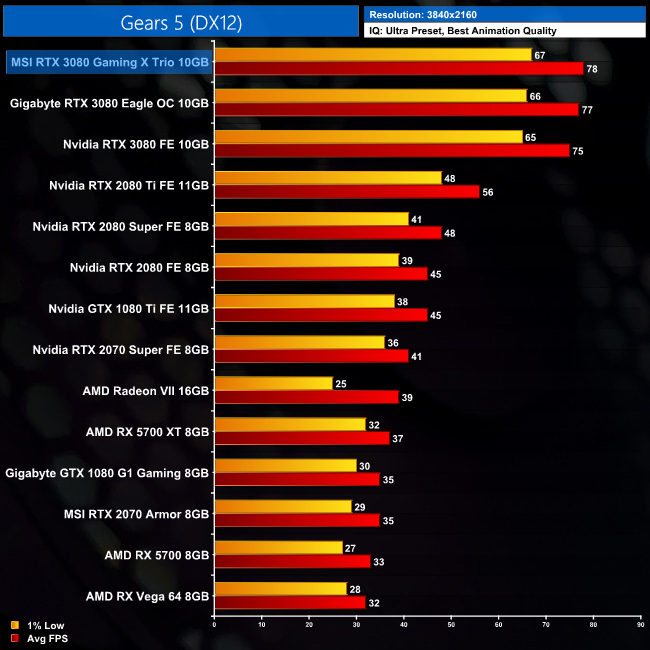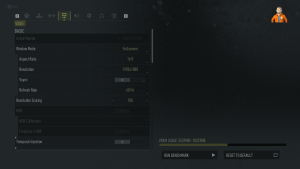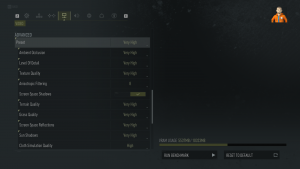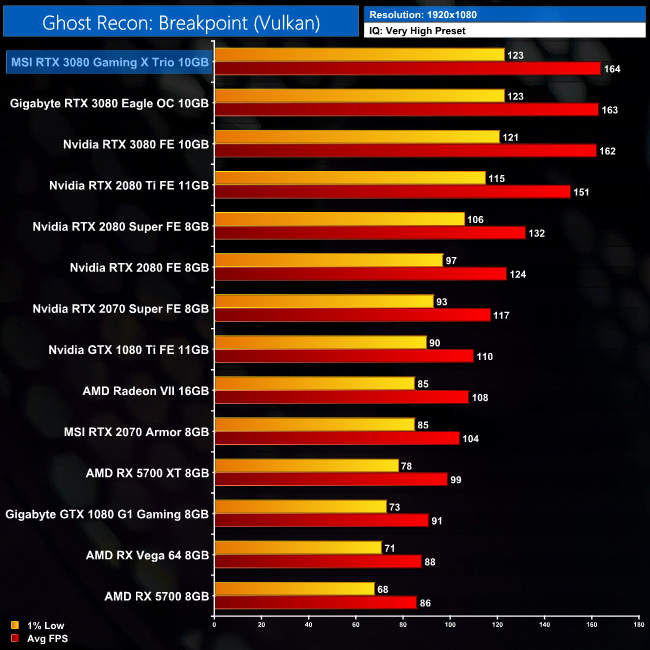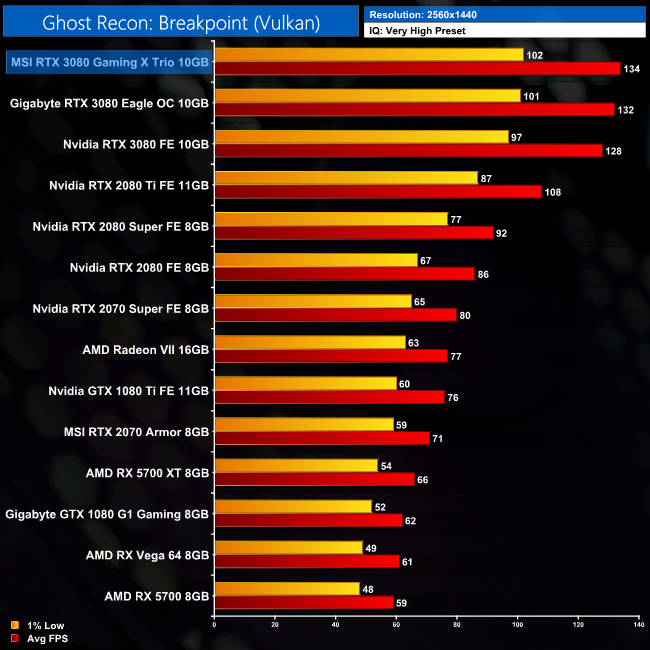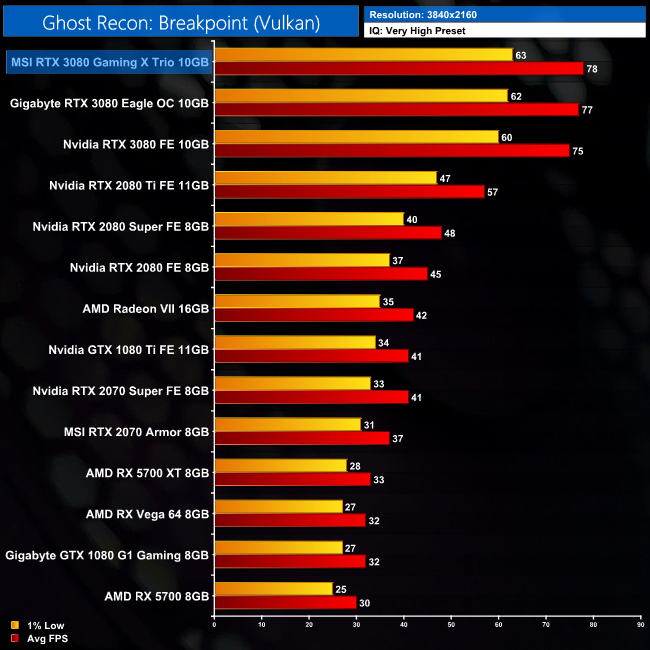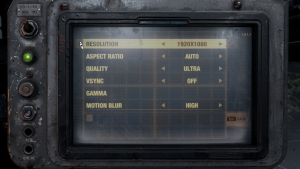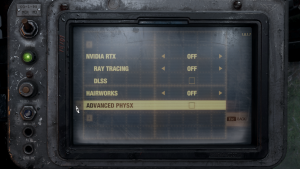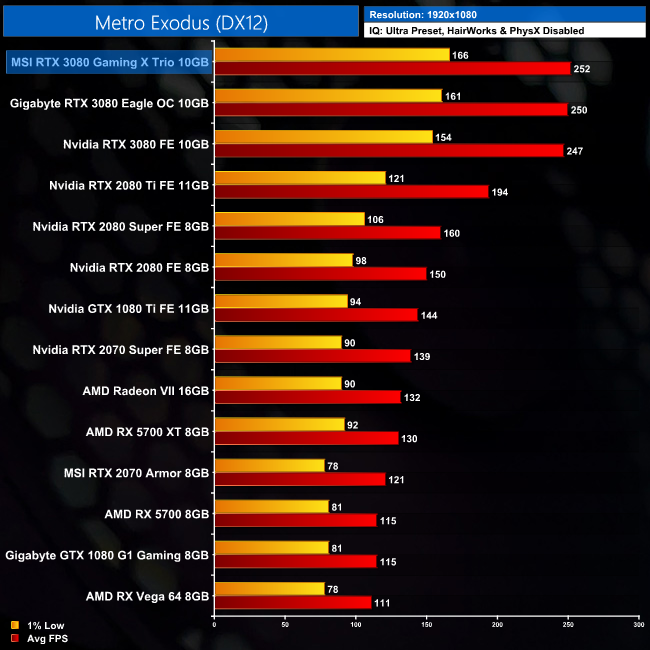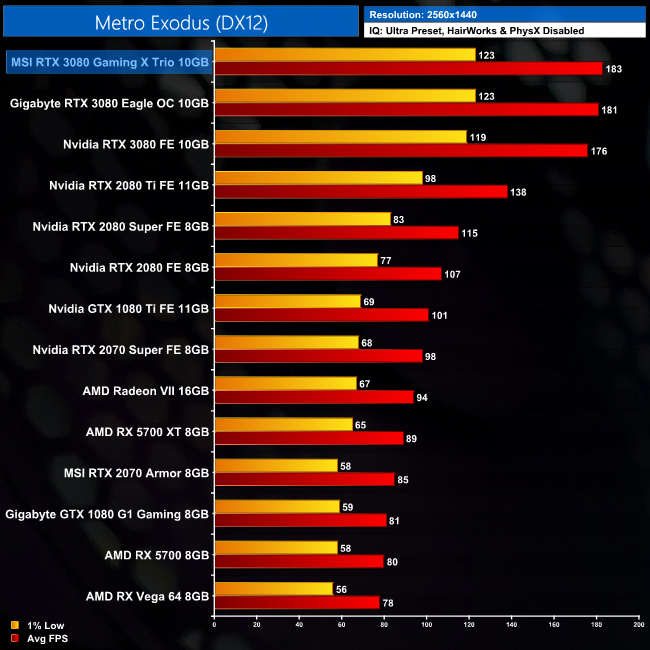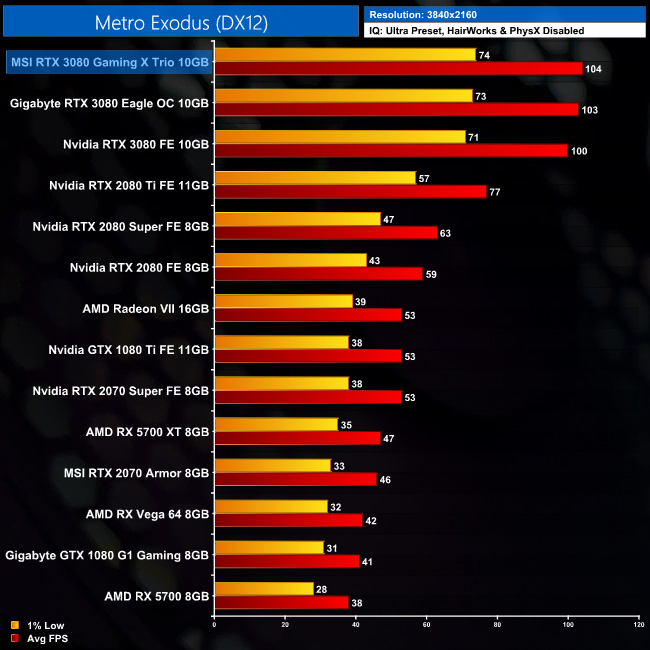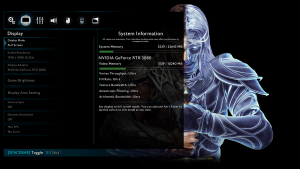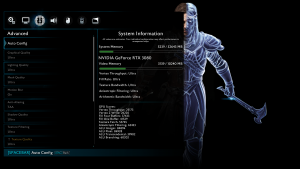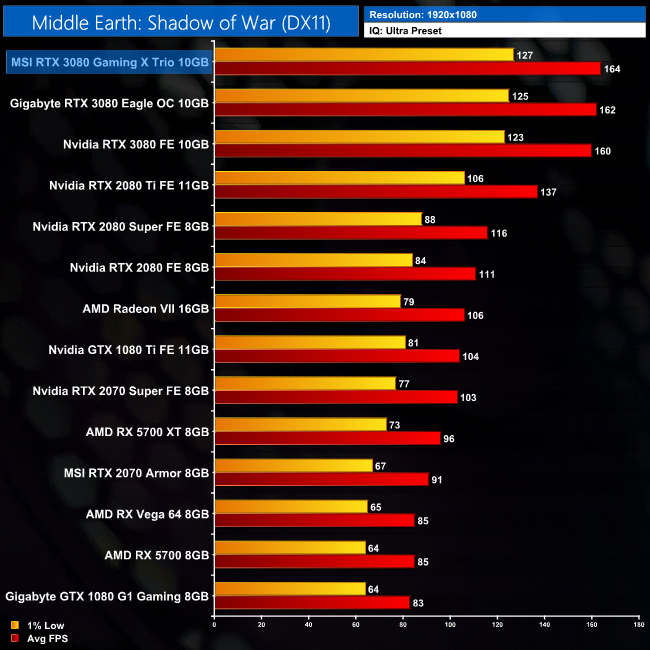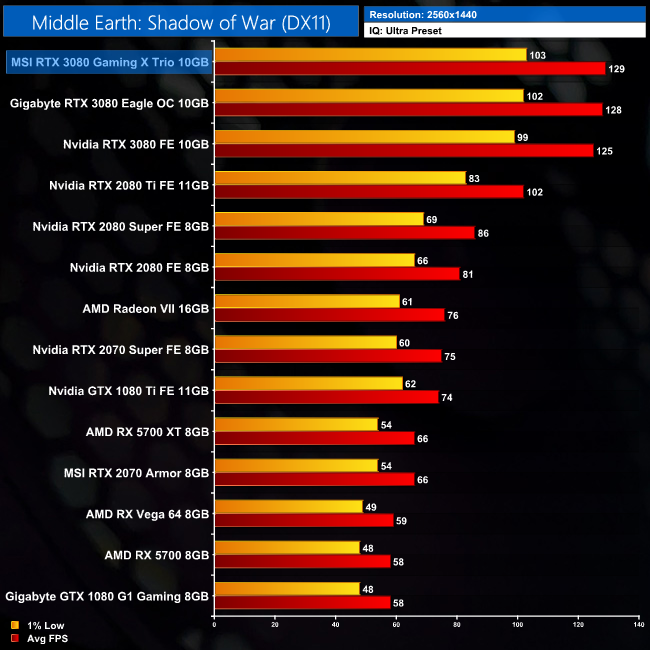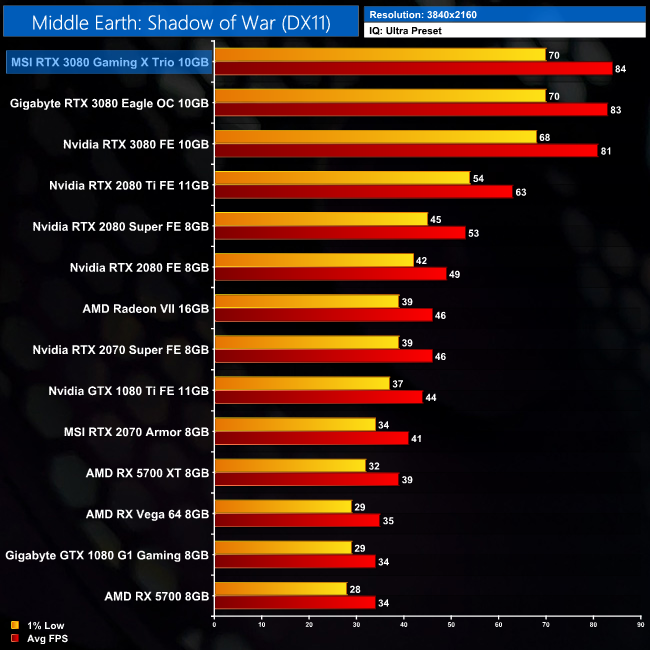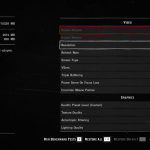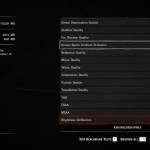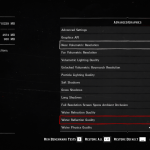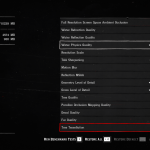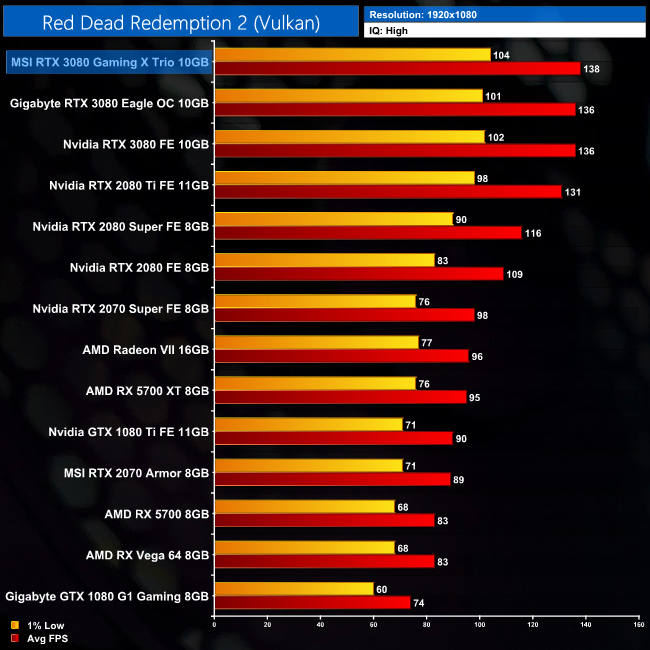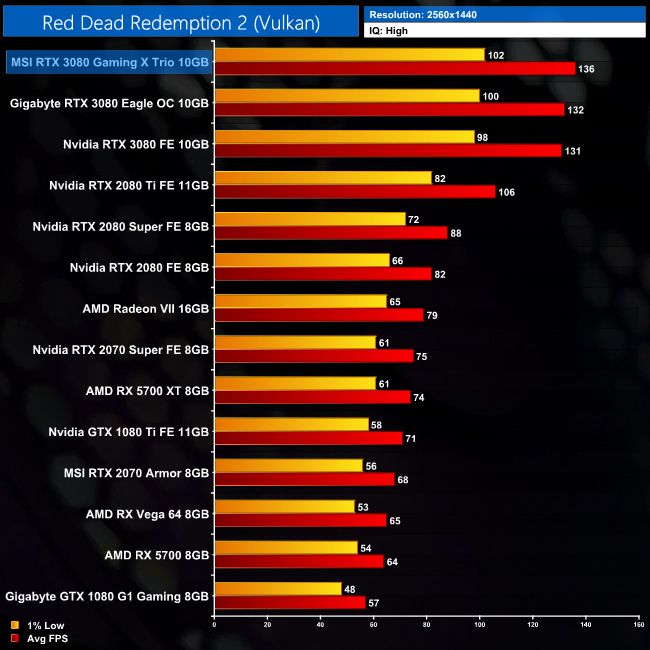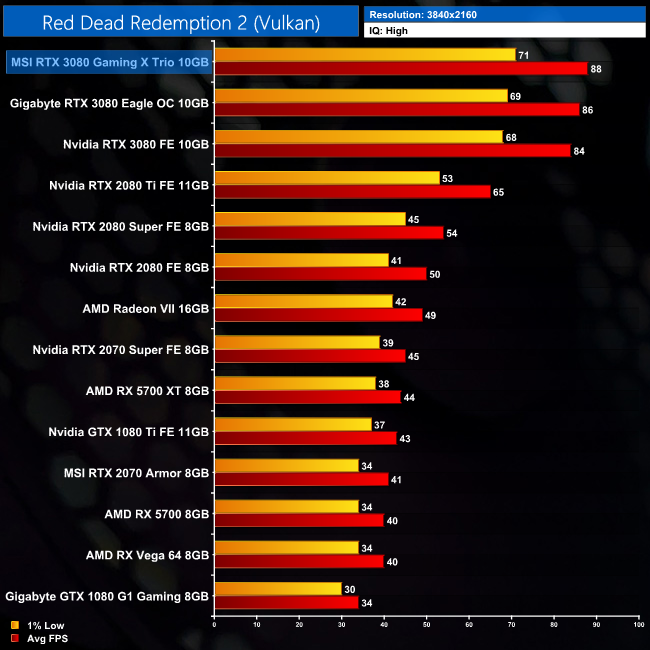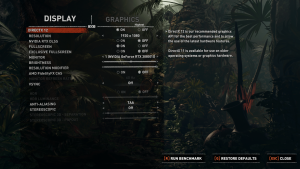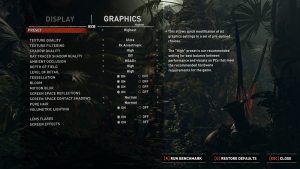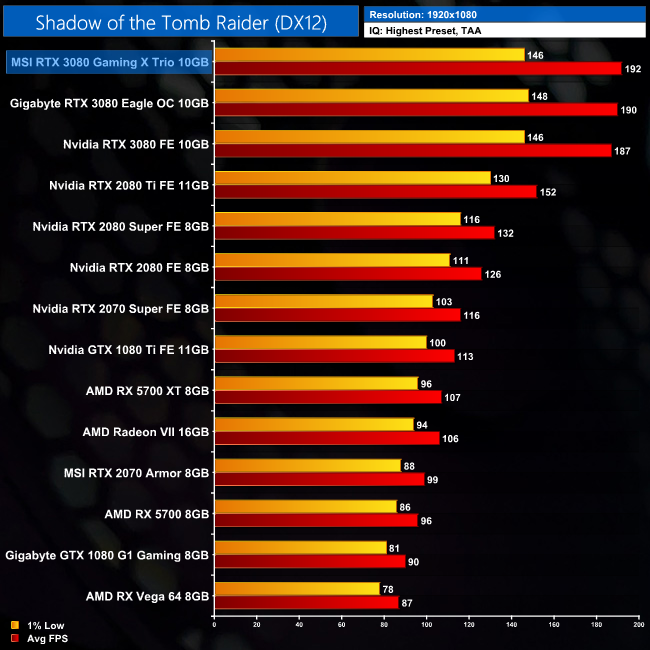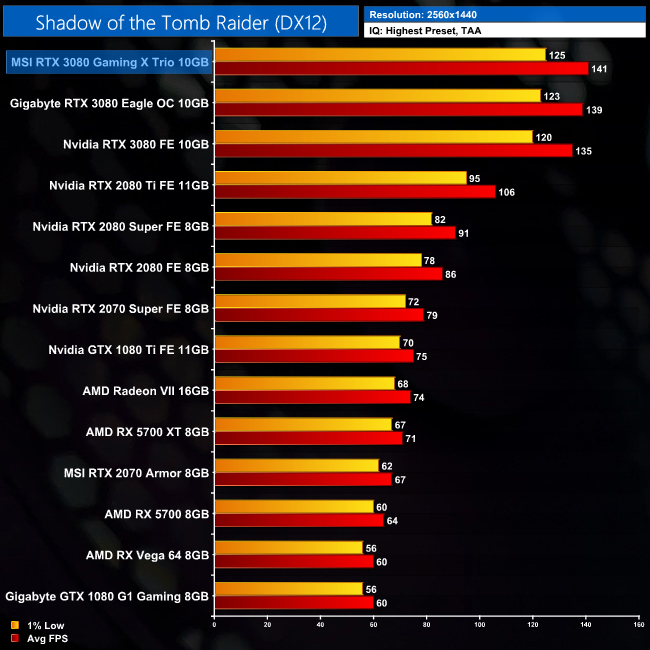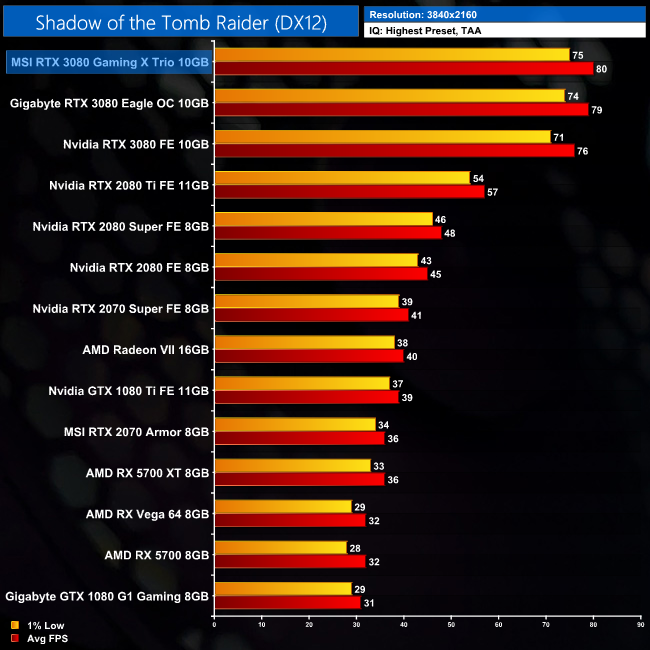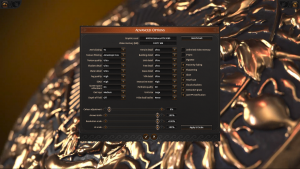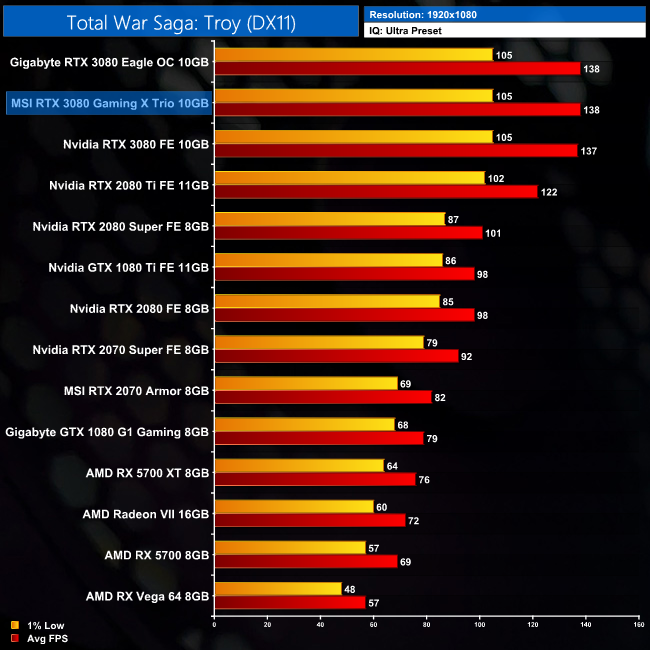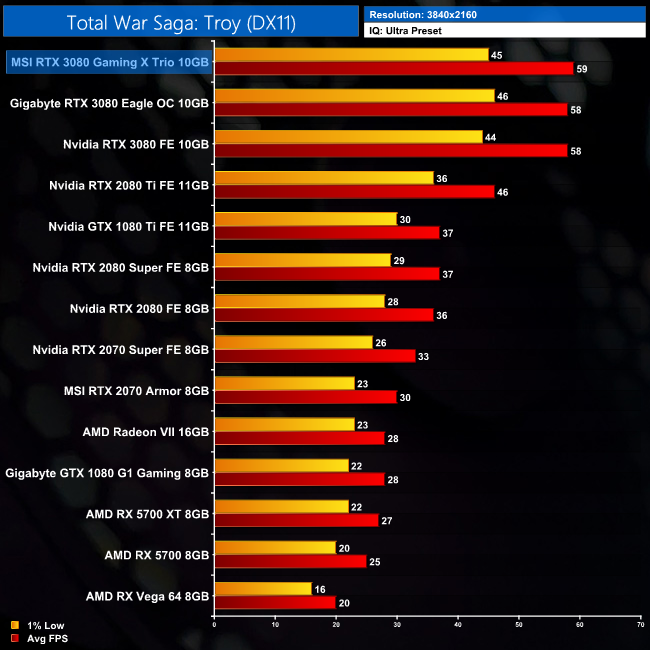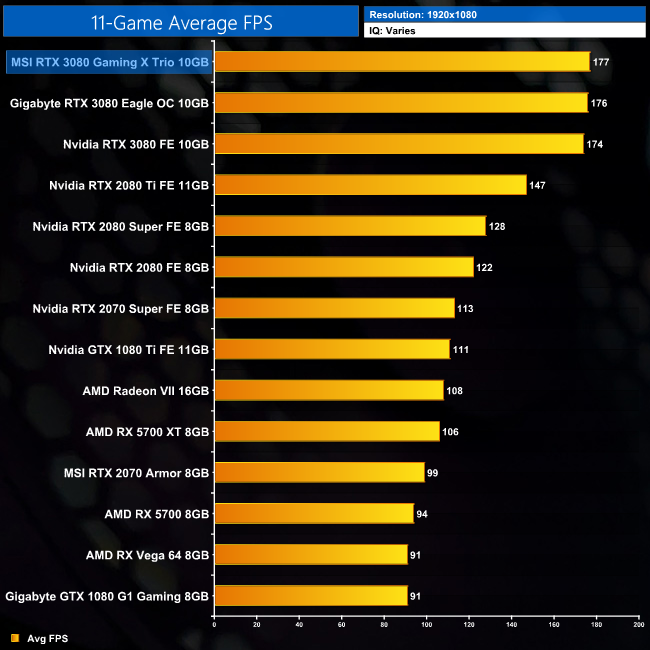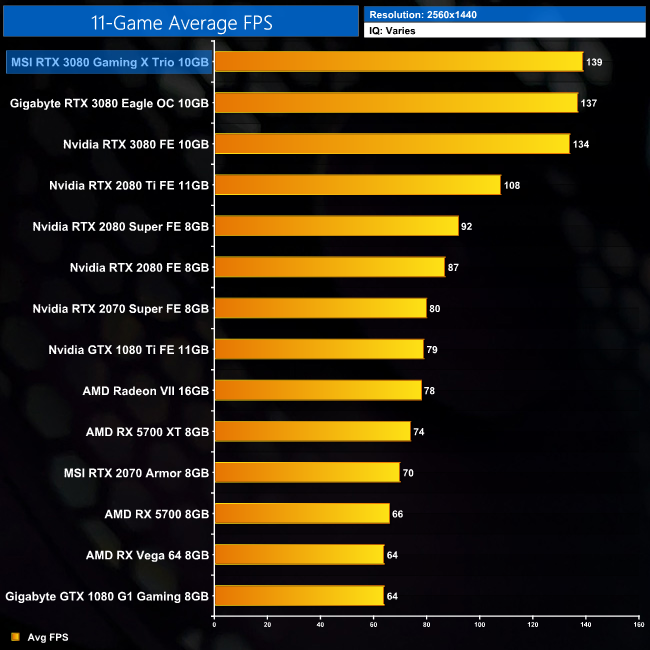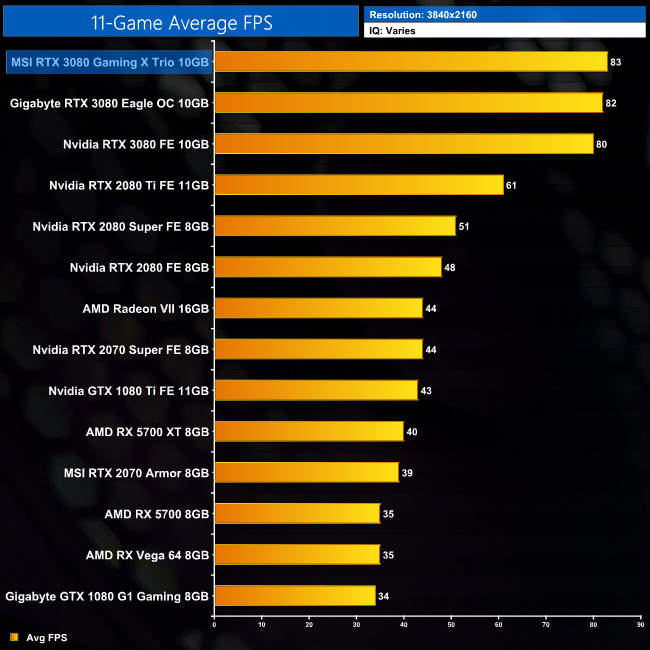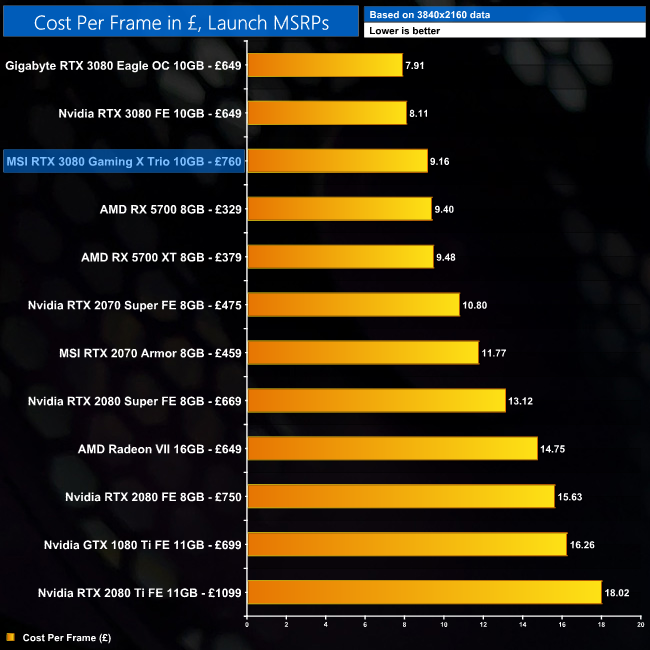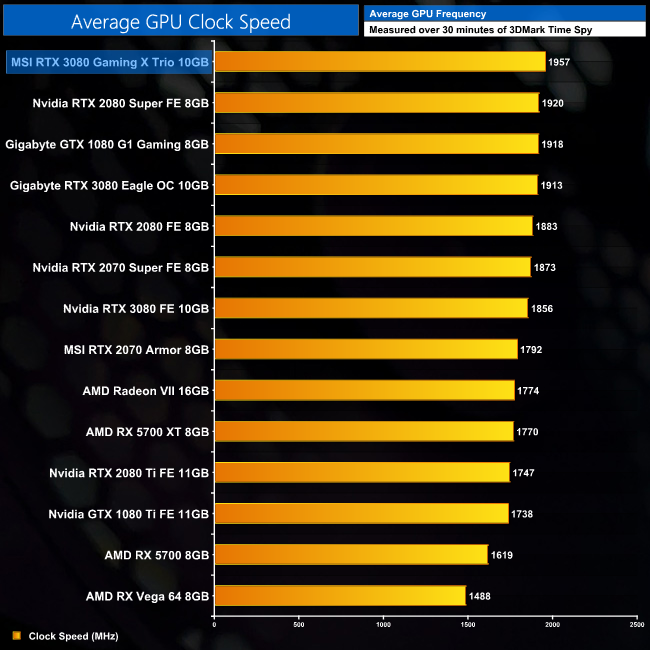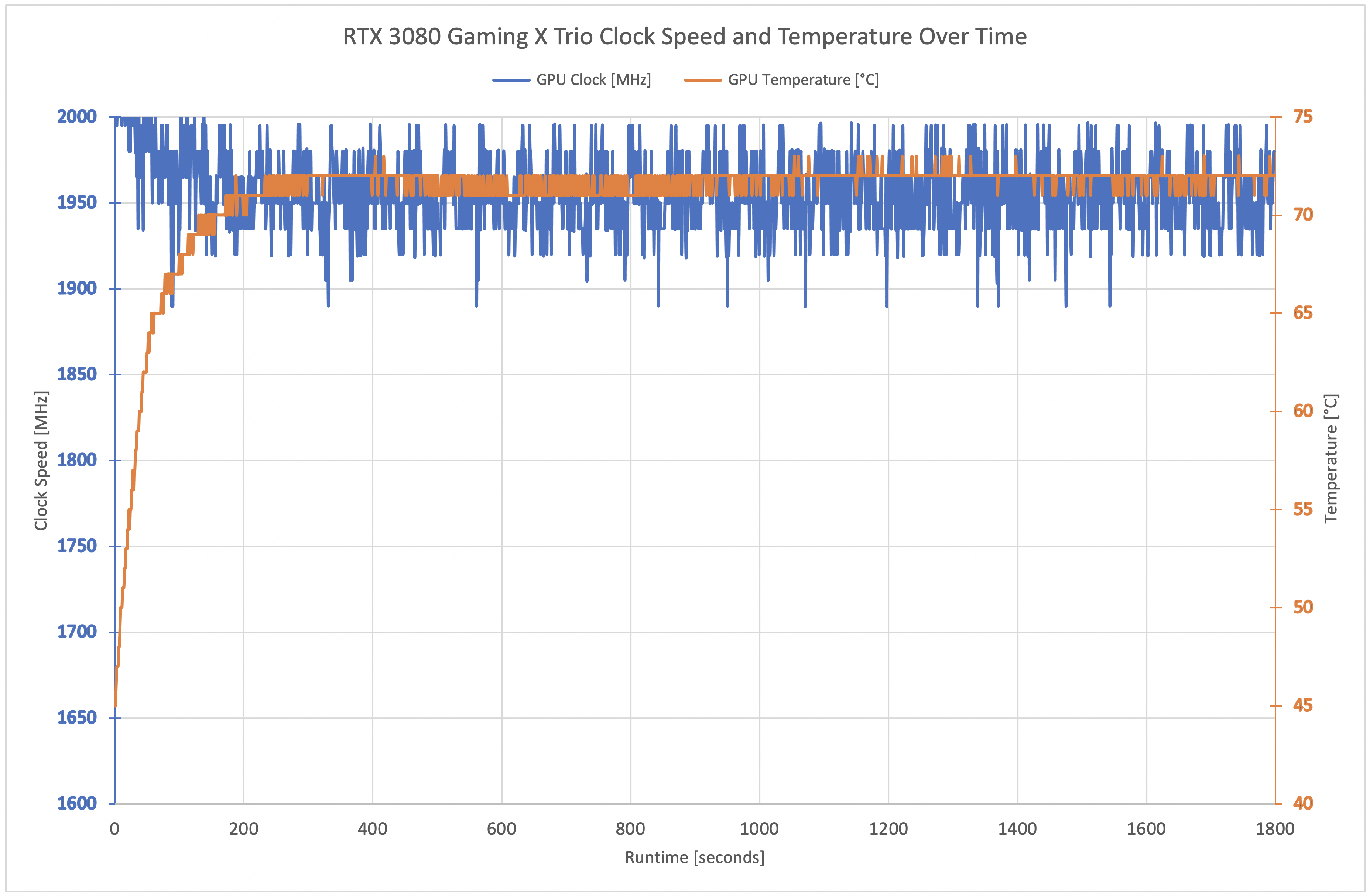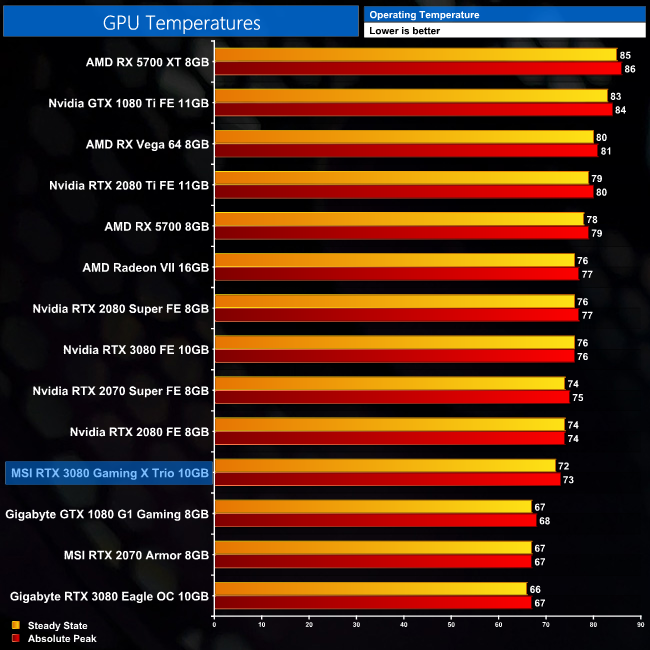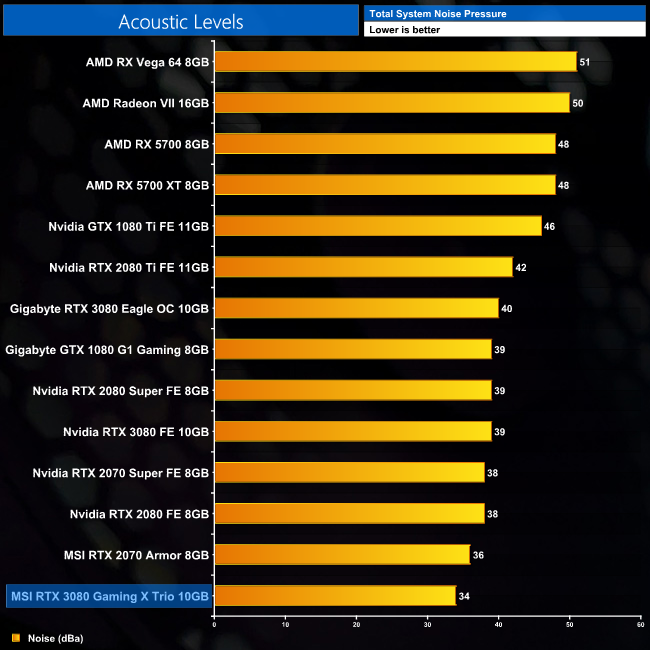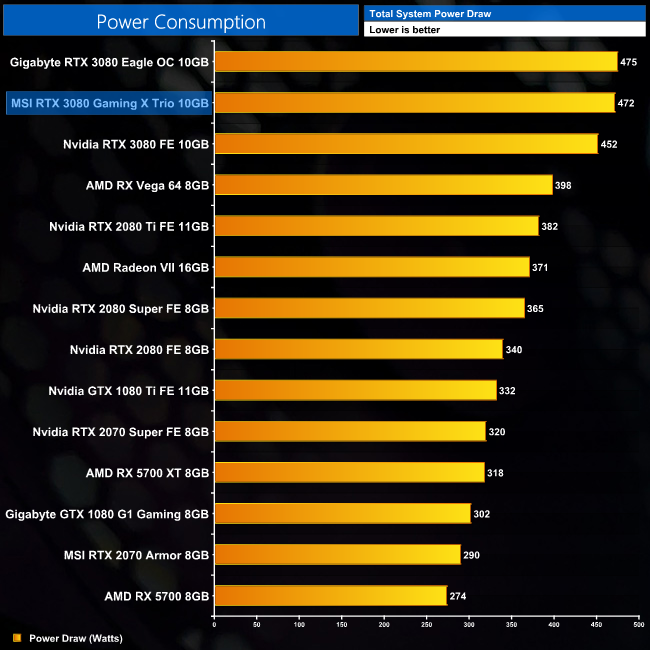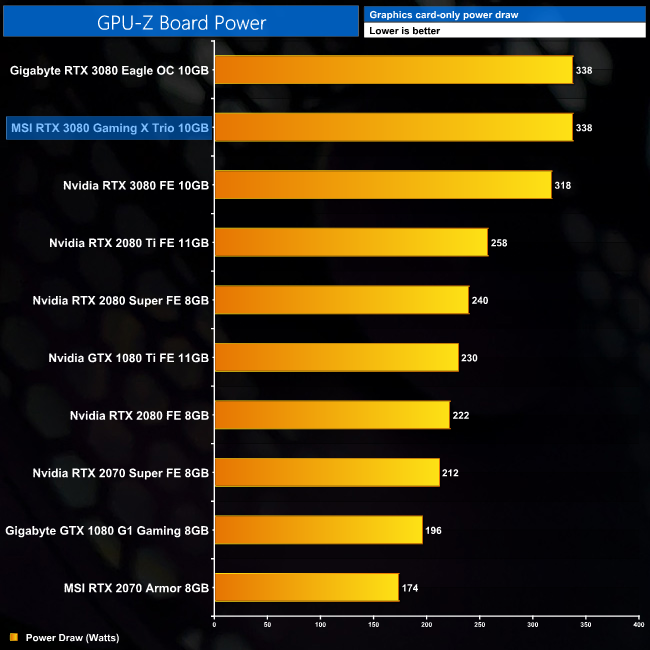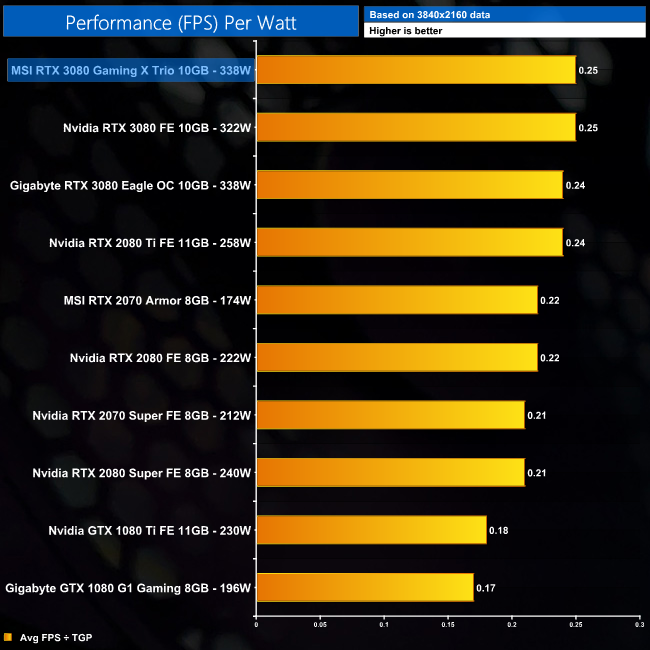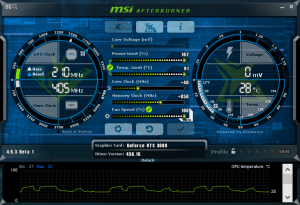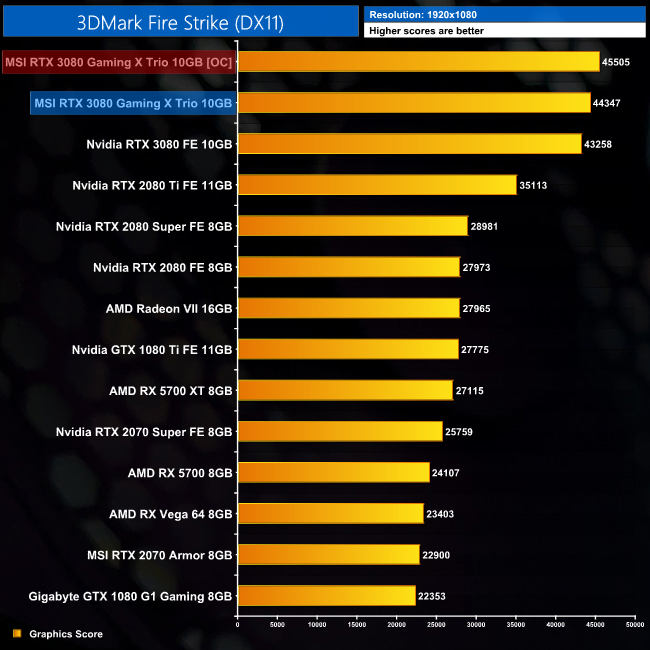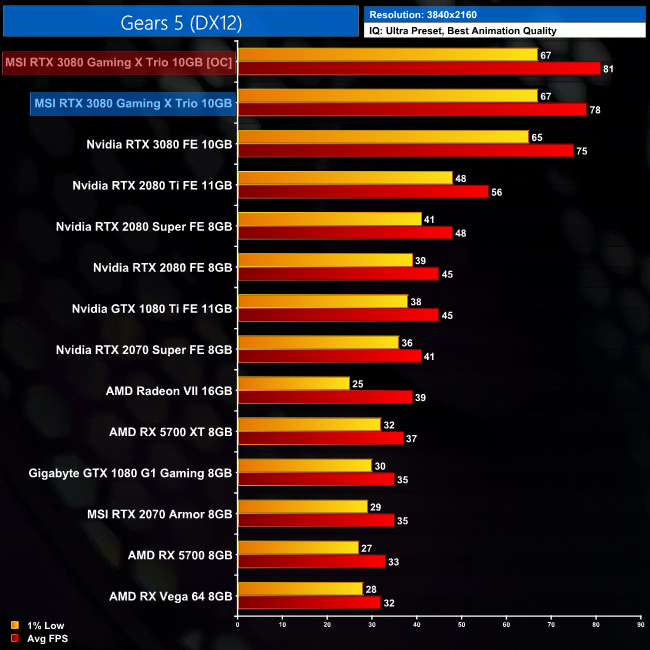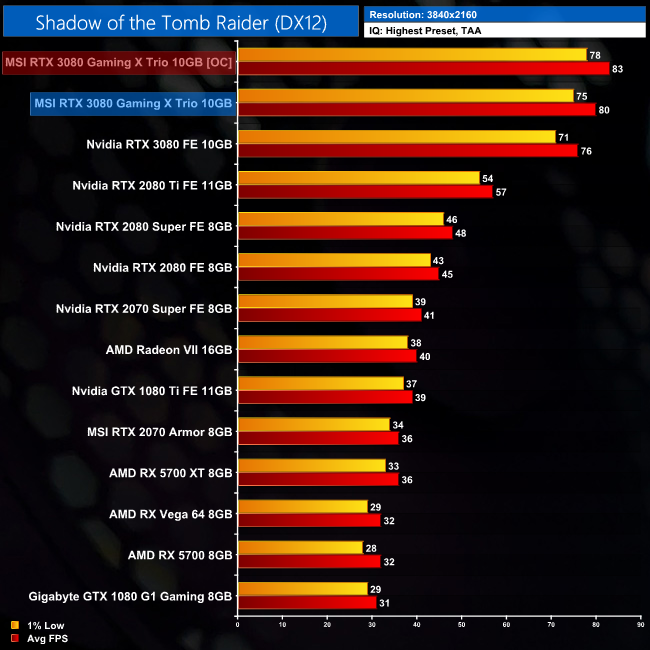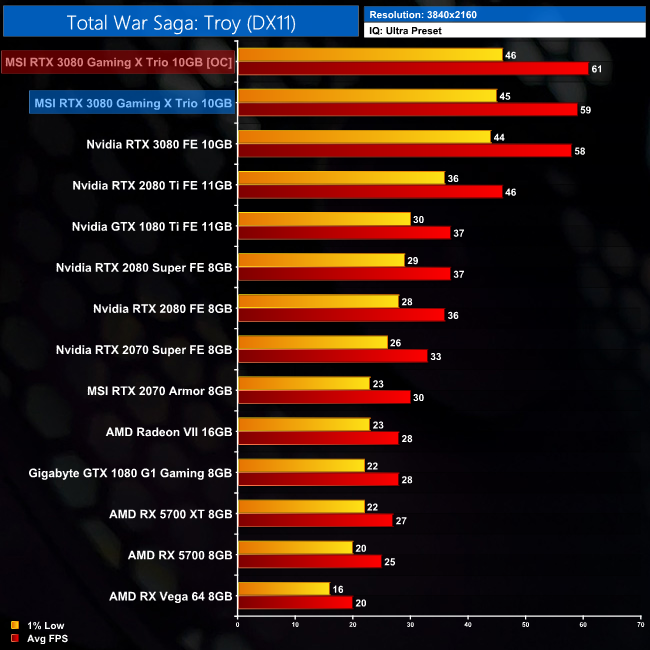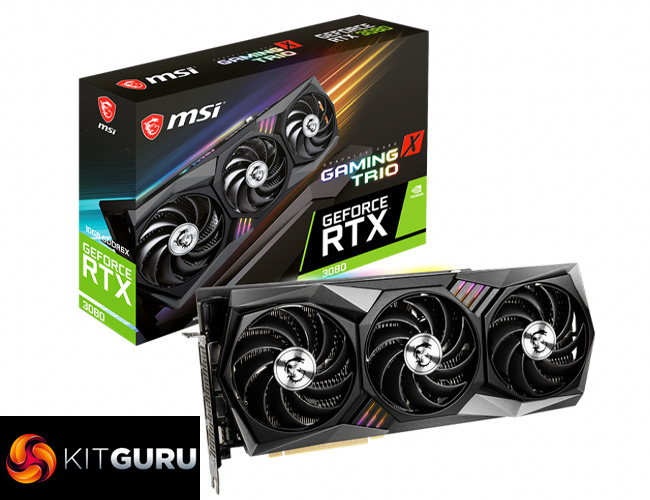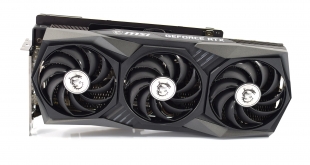
Barely any time has passed since we got our first look at just how fast the RTX 3080 really is, but today we are finding out whether it can go even faster. That's because we are looking at MSI's RTX 3080 Gaming X Trio, a huge graphics card with a triple-fan cooler, that also ships with a factory overclock of over 100MHz. It's certainly not cheap at £759.99, but if you want the best of the best, is this the card to buy?
MSI's Gaming X Trio has always been a premium offering, and that is certainly the case with this RTX 3080 model, as it is priced almost £110 more than the RTX 3080's £649 MSRP. For that extra cash, MSI promises increased performance, lower noise levels and lower temperatures, while also offering plentiful RGB lighting for those looking for some bling.
Here, we find out just how much faster this card is up against Nvidia's Founders Edition, and whether or not the large cooler can yield significantly improved thermals and acoustics.
| GPU | RTX 3090 | RTX 3080 | RTX 2080 Ti (FE) | RTX 2080 SUPER | RTX 2080 (FE) |
| SMs | 82 | 68 | 68 | 48 | 46 |
| CUDA Cores | 10496 | 8704 | 4352 | 3072 | 2944 |
| Tensor Cores | 328 | 272 | 544 | 384 | 368 |
| RT Cores | 82 | 68 | 68 | 48 | 46 |
| Texture Units | 328 | 272 | 272 | 192 | 184 |
| ROPs | 112 | 96 | 88 | 64 | 64 |
| GPU Boost Clock | 1695 MHz | 1710 MHz | 1635 MHz | 1815 MHz | 1800 MHz |
| Memory Data Rate | 19.5 Gbps | 19 Gbps | 14 Gbps | 15.5 Gbps | 14 Gbps |
| Total Video Memory | 24GB GDDR6X | 10GB GDDR6X | 11GB GDDR6 | 8GB GDDR6 | 8GB GDDR6 |
| Memory Interface | 384-bit | 320-bit | 352-bit | 256-bit | 256-bit |
| Memory Bandwidth | 936 GB/Sec | 760 GB/Sec | 616 GB/sec | 496.1 GB/sec | 448 GB/sec |
| TGP | 350W | 320W | 260W | 250W | 225W |
Just before diving into the details, it's worth reminding ourselves of the key specs for the RTX 3080. Built on Nvidia's GA102 GPU, fabricated on Samsung's 8nm process, RTX 3080 houses 8704 CUDA cores, 68 RT Cores and 272 Tensor cores.
A reference board would come clocked at 1710MHz, but this is the MSI Gaming X Trio, so of course it has a relatively hefty factory overclock, with a rated boost of 1815MHz. We do, of course, expect GPU Boost to bring actual frequency well above those levels, but we will look at that later in the review.
The 10GB VRAM is provided thanks to Micron's new GDDR6X memory. Operating at 19Gbps, over a 320-bit bus this gives total memory bandwidth of 760GB/s.
All of those cores, fast memory and factory overclock come at a cost, however, and that is power draw. Reference TGP for a RTX 3080 is 320W, but MSI has bumped this up to 340W, making it one of the most power-hungry GPUs I have ever tested.
MSI's box design for the RTX 3080 Gaming X Trio hasn't changed much since the last time we reviewed a graphics card from this same family, with a large photo of the card itself taking up most of the front of the box.
On the back, MSI highlights a few key aspects of the card, including the Tri Frozr 2 cooler and new Torx 4.0 fans.
Inside, MSI includes a plethora of guides and booklets, but more interesting is the GPU support bracket. As we will see below, the Gaming X Trio is a big graphics card, so GPU sag is a real issue. This bracket should help to reduce that problem by providing extra support to the card.
The design of the Gaming X Trio, at least in terms of its shroud, doesn't appear to have changed much from the last generation. It is still a mix of grey and black sections, with an edgy and angular shape.
What is new is the Tri Frozr 2 cooler, and the three Torx 4.0 fans. Most obviously, all of the three fans are the same size, at approximately 90mm. With something like the 2080 Gaming X Trio, the fan closest to the I/O bracket was smaller than the other two.
We can also see the fans themselves have a different design. The key thing here is that the fan blades now come in pairs, with an outer section that directly attaches the two blades together. MSI says this ‘focuses airflow into the updated TRI FROZR 2 cooling system', delivering 20% increased pressure compared to Torx 3.0.
Now then, as for the actual size of the thing, it is not small… measuring in at 323 x 140 x 56mm. Considering it also weighs over 1.5KG, we can see why MSI deemed it a good idea to include that GPU support bracket!
A large RGB strip is visible from the front side of the card, with the MSI and GeForce RTX logos also visible just below.
As for the backplate, this may look like standard fare at first glance, but interestingly this is actually made from graphene. MSI claims this is actually four times stronger than an equivalent plastic backplate, and twenty times more efficient for heat dissipation. The latter point doesn't come as surprise as nobody adds a plastic backplate to actually dissipate heat – when a plastic backplate is used, it's really just for aesthetics. Nonetheless, it is interesting to see MSI doing something a bit different here.
Next up we come to the power connectors, and MSI is taking no chances here, with a total of three 8-pin plugs required. Considering two 8-pins, plus the PCIe slot, are capable of delivering 375W, this is almost certainly overkill for an RTX 3080, but we will come to power draw later in this review.
As for the display outputs, it is the standard allocation for RTX 3080, with 3x DisplayPort 1.4a, and 1x HDMI 2.1.
Prising off the heatsink gives us a look at the PCB, which is a custom job from MSI. It uses a 16-stage power delivery, which I believe is 13+3, using ON Semi’s NCP302150 MOSFETs rated up to 50 A. Technically, these are co-packaged power stage solutions that integrate the high-side and low-side MOSFETs with the driver in a single, space-saving package. Micron’s D8BGW GDDR6X memory modules are also on show, while we can note MSI has added an extra support bracket to prevent any bending of the PCB.
Meanwhile, the cooler is hefty unit, with two separate fin stacks. These are joined by a total of seven nickel-plated heatpipes, six of which measure 6mm, while the other pipe is thicker at 8mm. These pipes also make direct contact with the GPU die, while the memory and VRM contact with additional plates via thermal pads.
Driver Notes
- All Nvidia GPUs (except RTX 3000) were benchmarked with the 452.06 driver.
- RTX 3080 was benchmarked with the 456.16 driver supplied to press.
- All AMD GPUs were benchmarked with the Adrenalin 20.8.2 driver.
Test System
We test using the a custom built system from PCSpecialist, based on Intel's latest Comet Lake-S platform. You can read more about it over HERE, and configure your own system from PCSpecialist HERE.
| CPU |
Intel Core i9-10900K
Overclocked to 5.1GHz on all cores |
| Motherboard |
ASUS ROG Maximus XII Hero Wi-Fi
|
| Memory |
Corsair Vengeance DDR4 3600MHz (4 X 8GB)
CL 18-22-22-42
|
| Graphics Card |
Varies
|
| System Drive |
500GB Samsung 970 Evo Plus M.2
|
| Games Drive | 2TB Samsung 860 QVO 2.5″ SSD |
| Chassis | Fractal Meshify S2 Blackout Tempered Glass |
| CPU Cooler |
Corsair H115i RGB Platinum Hydro Series
|
| Power Supply |
Corsair 1200W HX Series Modular 80 Plus Platinum
|
| Operating System |
Windows 10 2004
|
Comparison Graphics Cards List
- Gigabyte RTX 3080 Eagle OC 10GB
- Nvidia RTX 3080 FE 10GB
- Nvidia RTX 2080 Ti FE 11GB
- Nvidia RTX 2080 Super FE 8GB
- Nvidia RTX 2080 FE 8GB
- Nvidia RTX 2070 Super FE 8GB
- MSI RTX 2070 Armor 8GB
- Nvidia GTX 1080 Ti FE 11GB
- Gigabyte GTX 1080 G1 Gaming 8GB
- AMD Radeon VII 16GB
- AMD RX 5700 XT 8GB
- AMD RX 5700 8GB
- AMD RX Vega 64 8GB
Software and Games List
- 3DMark Fire Strike & Fire Strike Ultra (DX11 Synthetic)
- 3DMark Time Spy (DX12 Synthetic)
- 3DMark Port Royal (DXR Synthetic)
- Control (DX12)
- Death Stranding (DX12)
- The Division 2 (DX12)
- Far Cry New Dawn (DX11)
- Gears 5 (DX12)
- Ghost Recon: Breakpoint (Vulkan)
- Metro: Exodus (DX12)
- Middle Earth: Shadow of War (DX11)
- Red Dead Redemption 2 (Vulkan)
- Shadow of the Tomb Raider (DX12)
- Total War Saga: Troy (DX11)
We run each benchmark/game three times, and present mean averages in our graphs. We use OCAT to measure average frame rates as well as 1% low values across our three runs.
3DMark Fire Strike is a showcase DirectX 11 benchmark designed for today’s high-performance gaming PCs. It is our [FutureMark’s] most ambitious and technical benchmark ever, featuring real-time graphics rendered with detail and complexity far beyond what is found in other benchmarks and games today.
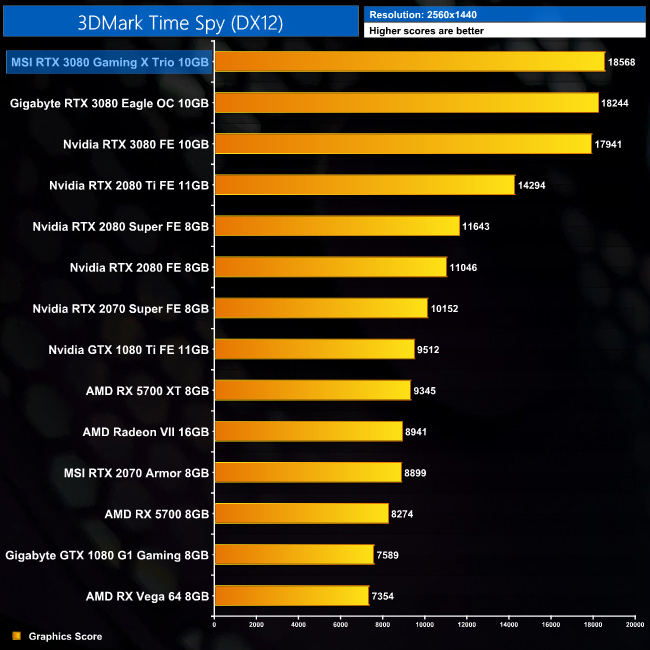
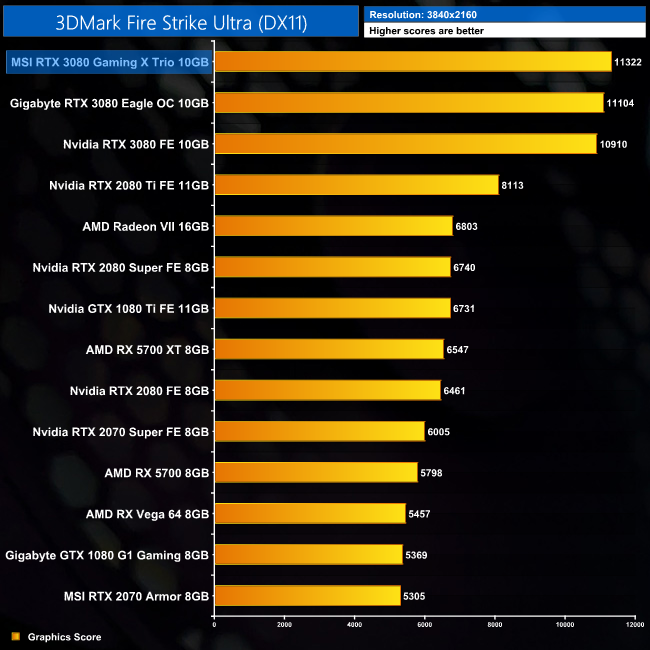
In our first 3DMark benchmarks, the performance of the Gaming X Trio is a little ahead of the Founders Edition. Its scores are 3% higher than the Founders Edition in Fire Strike and Time Spy, while that stretches to 4% in Fire Strike Ultra.
3DMark Port Royal is the world’s first dedicated real-time ray tracing benchmark for gamers. You can use Port Royal to test and compare the real-time ray tracing performance of any graphics card that supports Microsoft DirectX Raytracing. As well as benchmarking performance, 3DMark Port Royal provides a realistic and practical example of what to expect from ray tracing in upcoming games.
Port Royal picks up where Fire Strike Ultra left off, meaning we see another 4% performance uplift for the MSI card versus Nvidia's Founders Edition.
Control is an action-adventure video game developed by Remedy Entertainment and published by 505 Games. Control was released on 27 August 2019 for Microsoft Windows, PlayStation 4, and Xbox One. (Wikipedia).
Engine: Northlight Engine. We test using the High preset, with 4x MSAA, DX12 API.
Our first game of the day is Control, and here the Gaming X Trio takes top spot at every resolution tested. At 4K, its 2FPS lead over the Founders Edition works out as a 4% performance uplift.
Death Stranding is an action game developed by Kojima Productions. It is the first game from director Hideo Kojima and Kojima Productions after their split from Konami in 2015. It was released by Sony Interactive Entertainment for the PlayStation 4 in November 2019 and by 505 Games for Windows in July 2020. (Wikipedia).
Engine: Decima. We test using the Very High preset, with TAA, DX12 API.
As for Death Stranding, this a title where we see more benefit to the Gaming X Trio's increased clock speed as we step up in resolution. Demonstrating this, the card is 2% faster than the Founders Edition at 1080p, 3% faster at 1440p and then 4% faster at 4K.
Tom Clancy's The Division 2 is an online action role-playing video game developed by Massive Entertainment and published by Ubisoft. The sequel to Tom Clancy's The Division (2016), it is set in a near-future Washington, D.C. in the aftermath of a smallpox pandemic, and follows an agent of the Strategic Homeland Division as they try to rebuild the city. (Wikipedia).
Engine: Snowdrop. We test using the Ultra preset, but with V-Sync disabled, DX12 API.
Next up we come to The Division 2, and here the 3080 Gaming X Trio actually does best, relatively speaking, at 1440p where it delivers a 5% gain over the Nvidia 3080. At 4K, the margin is ever so slightly smaller, at 4%.
Far Cry New Dawn is an action-adventure first-person shooter developed by Ubisoft Montreal and published by Ubisoft. The game is a spin-off of the Far Cry series and a narrative sequel to Far Cry 5. It was released for Microsoft Windows, PlayStation 4 and Xbox One on February 15, 2019. (Wikipedia).
Engine: Dunia 2. We test using the Ultra preset, with the HD Textures pack, DX11 API.
Far Cry New Dawn really doesn't see any benefit from the extra frequency of the Gaming X Trio when looking at the 1080p and 1440p results, but that's because we're CPU limited at those resolutions. At 4K, the MSI card comes in 4% faster than the Founders Edition.
Gears 5 is a third-person shooter video game developed by The Coalition and published by Xbox Game Studios for Microsoft Windows and Xbox One. It is the sixth instalment of the Gears of War series, and is the second Gears of War game not to be developed by Epic Games.
Engine: Unreal Engine 4. We test using the Ultra preset, with Best Animation Quality (instead of Auto), DX12 API.
Gears 5 is another case of the Gaming X Trio delivering its best at 4K, where it comes in 4% faster than the Nvidia FE. With an average of almost 80FPS in a demanding title like this, it really shows us how good this GPU is.
Tom Clancy's Ghost Recon Breakpoint is an online tactical shooter video game developed by Ubisoft Paris and published by Ubisoft. The game was released worldwide on 4 October 2019, for Microsoft Windows, PlayStation 4 and Xbox One, (Wikipedia).
Engine: AnvilNext 2.0. We test using the Very High preset, with AA disabled, Vulkan API.
Ghost Recon: Breakpoint actually sees the exact same performance results as Gears 5. At 4K, the Gaming X Trio averages 78FPS in both games, taking a 4% lead over the Founders Edition.
Metro Exodus is a first-person shooter video game developed by 4A Games and published by Deep Silver in 2019. It is the third instalment in the Metro video game series based on Dmitry Glukhovsky's novels, following the events of Metro 2033 and Metro: Last Light. (Wikipedia).
Engine: 4A Engine. We test using the Ultra preset, but with Hairworks and Advanced PhysX turned off, DX12 API.
RTX 3080 chews through Metro Exodus, delivering over 100FPS even at 4K. The Gaming X Trio averages 104FPS at this resolution, which is both 4FPS and 4% better than the Nvidia Founders Edition.
Middle-earth: Shadow of War is an action role-playing video game developed by Monolith Productions and published by Warner Bros. Interactive Entertainment. It is the sequel to 2014’s Middle-earth: Shadow of Mordor, and was released worldwide for Microsoft Windows, PlayStation 4, and Xbox One on October 10, 2017. (Wikipedia).
Engine: LithTech Firebird. We test using the Very High preset, DX11 API.
By now the overall performance trend of this card is well established, and Shadow of War provides another example of it – the Gaming X Trio shows a 4% performance uplift versus Nvidia's design, at 4K
Red Dead Redemption 2 is a 2018 action-adventure game developed and published by Rockstar Games. The game is the third entry in the Red Dead series and is a prequel to the 2010 game Red Dead Redemption. Red Dead Redemption 2 was released for the PlayStation 4 and Xbox One in October 2018, and for Microsoft Windows and Stadia in November 2019. (Wikipedia).
Engine: Rockstar Advance Game Engine (RAGE). We test by manually selecting High settings, not using a preset, including TAA, Vulkan API.
Red Dead Redemption 2 sees a slightly bigger boost to frame rates, with the MSI 3080 averaging 88FPS at 4K. As a 4FPS increase over the Founders Edition, this works out as a 5% uplift.
Shadow of the Tomb Raider is an action-adventure video game developed by Eidos Montréal in conjunction with Crystal Dynamics and published by Square Enix. It continues the narrative from the 2013 game Tomb Raider and its sequel Rise of the Tomb Raider, and is the twelfth mainline entry in the Tomb Raider series. The game released worldwide on 14 September 2018 for Microsoft Windows, PlayStation 4 and Xbox One. (Wikipedia).
Engine: Foundation Engine. We test using the Highest preset, with TAA, DX12 API.
Just like Red Dead Redemption 2, the Gaming X Trio is 5% faster than the Founders Edition in Shadow of the Tomb Raider, when testing at 4K.
Total War Saga: Troy is a 2020 turn-based strategy video game developed by Creative Assembly Sofia and published by Sega. The game was released for Windows on 13 August 2020 as the second installment in the Total War Saga subseries, succeeding Thrones of Britannia (2018). (Wikipedia).
Engine: TW 3 Engine. We test using the Ultra preset, DX11 API.
Total War Saga: Troy is the game that benefits least from the additional clock speed of the Gaming X Trio. It is just 1% faster than the Founders Edition at 1080p, but only 2% faster at 1440p and 4K.
Here we present frame rate figures for each graphics card, averaged across all 11 games on test today. These figures can disguise significant variations in performance from game to game, but provide a useful overview of the sort of performance you can expect at each resolution tested.
Based on the 11 games we looked at, it's no surprise to see the Gaming X Trio coming out as the overall performance leader, regardless of the resolution tested. It does show its biggest gains at 1440p and 4K, though, where it is on average 4% faster than the Nvidia Founders Edition.
Using the average frame rate data presented on the previous page, here we look at the cost per frame using the UK MSRP launch prices for each GPU.
Due to the £759.99 asking price of the Gaming X Trio – an increase of 17% over the £649 MSRP – coupled with its 4% uplift in performance, cost per frame is less favourable for this graphics card than both the Founders Edition, and Gigabyte's Eagle model. However, it is still better than every other GPU on our chart, clearly showing just how good value the RTX 3080 really is.
Here we present the average clock speed for each graphics card while running the 3DMark Time Spy stress test for 30 minutes. We use GPU-Z to record the GPU core frequency during the Time Spy runs. We calculate the average core frequency during the 30 minute run to present here.
Click to enlarge.
With its rated boost clock of 1815MHz, it is no surprise to see the Gaming X Trio proved about 100MHz faster than the Founders Edition, on average. It boosted as high as 2040MHz out of the box, but that sort of behaviour isn't sustainable in the long run. Even so, an average frequency of over 1950MHz is highly impressive.
For our temperature testing, we measure the peak GPU core temperature under load. A reading under load comes from running the 3DMark Time Spy stress test for 30 minutes.
If we look at thermal performance in isolation, things may not seem so impressive here. We saw the GPU hovering between 72-73C during our 30 minute stress test, which is certainly not at all bad, and it is a 3C improvement over the Founders Edition. I was expecting slightly more from this cooler, however, considering its sheer size and new design features – but we find out more about this on the next page…
We take our noise measurements with the sound meter positioned 1 foot from the graphics card. I measured the noise floor to be 32 dBA, thus anything above this level can be attributed to the graphics cards. The power supply is passive for the entire power output range we tested all graphics cards in, while all CPU and system fans were disabled. A reading under load comes from running the 3DMark Time Spy stress test for 30 minutes.
It’s when we move to noise testing that we understand why the thermal performance wasn't as impressive as we hoped. Simply put, the Gaming X Trio is – for all intents and purposes – inaudible when under load. Its fans spun to about 1360rpm under load, but we measured noise levels at barely 34db from a 30cm distance, which is actually coming very close to our noise floor.
It’s certainly one of the quietest graphics cards I have ever tested, to the point where you can only really hear the fans by pressing your ear right against the case. It's seriously impressive stuff from MSI.
We measure system-wide power draw from the wall while running the 3DMark Time Spy stress test for 30 minutes.
Total system power draw comes in just over 470W, putting this MSI card in a similar position to the Gigabyte Eagle.
We also use GPU-Z to measure Board Power (graphics card-only power draw). This is currently only available for Nvidia cards, which is why we have excluded AMD results from the chart. Aside from the fact this is software-based reporting, and not a hardware measurement of the PCIe power cables and PCIe slot (for that we’d need something like PCAT), this should provide us more accurate data to work with as it is measuring only the GPU power, and not total system power which is a fundamentally imprecise measurement.
Looking at board power only, we can see the Gaming X Trio has a 340W power target, and it is pretty much bang on, with average power draw at 338W across our 30 minute stress test. This certainly suggests three 8-pin power connectors aren't really necessary, but I think MSI is perhaps trying to make this card appear more ‘enthusiast', as three 8-pins is certainly a talking point.
By using the GPU-Z Board Power data in conjunction with the 11-game average FPS data we presented earlier in this review, we can work out performance per Watt for each graphics card. This is presented as FPS per Watt.
Performance per Watt doesn't change for the Gaming X Trio when compared to the Founders Edition. It is slightly more power hungry, but also slightly faster, so the two balance themselves out.
Turning our hand to overclocking, we use MSI Afterburner to see how much more we could squeeze from this GPU. The answer is ‘not a lot', at least in terms of GPU frequency where we could only add a +40MHz offset. The GDDR6X memory is definitely more amenable to an overclock though, where we managed a +850MHz offset, bringing speeds to 20.7Gbps.
This overclock didn't net us huge gains, with an FPS boost between 3-4% in the games we rested. However, when we consider the card already ships with a decent factory overclock, performance was up to 9% higher than the Founders Edition at stock speeds.
There's no doubt about it, the MSI RTX 3080 Gaming X Trio is a highly impressive graphics card. Just a single day has passed since we stated the RTX 3080 Founders Edition is the fastest graphics card we have ever tested, and now that honour has passed to the Gaming X Trio.
That is thanks to the decent factory overclock applied to this GPU, with its rated boost clock of 1815MHz. In practice, we saw it running right around the 1960MHz mark, making it 100MHz faster than the Founders Edition.
Across the 11 games we tested today, that extra frequency resulted in the Gaming X Trio outperforming the Founders Edition by an average of 4%, at both 1440p and 4K. It may not sound like much, but I think the days of custom cards coming in 5-10% faster than the reference designs are now behind us.
Still, when you take an RTX 3080 and add more frequency, we get a GPU that is simply faster than anything else currently available. The Gaming X Trio is on average 37% faster than the RTX 2080 Ti, 64% faster than the RTX 2080 Super, and 75% faster than the RTX 2080, all at 4K.
Added to that, MSI's new Tri Frozr 2 cooler is a real work of art. Thermal performance may not seem that impressive at only 3C cooler than the Founders Edition, but that's only because the fan curve has clearly been prioritised towards low noise levels. I'd go as far to say the Gaming X Trio is the quietest graphics card I have ever tested… all while running at speeds not far off 2GHz.
Of course, if you want to drop temperatures below 70C, a simple bump to the fan speed will do that and the card still would be near silent. With that in mind, it would have been good to see MSI add dual-BIOS to the Gaming X Trio, both for redundancy purposes but also to give users a choice between a Performance profile, or a Quiet profile.
Overclocking the card didn't net us much in the way of extra performance, but a couple of things were conspiring against us here. First of all, from the three RTX 3080 cards we have now tested, it really does seem that the GA102 GPU doesn't have much left to give in terms of extra clock speed. Secondly, MSI has already eaten into 100MHz of that headroom with its factory overclock, so the fact we could only add a further 40MHz to the core isn't the end of the world.
In sum, the MSI RTX 3080 Gaming X Trio is a terrific graphics card, and it improves on the Founders Edition in some pretty significant ways. The clear downside is going to be pricing, as we have been told to expect this card to go for £759.99. Personally, I feel that it is much easier for RTX 3080 custom cards to come in with this sort of price, than was the case for the 20 series. The fact is, RTX 3080 is such good value anyway that adding another £110 for a card like this still makes it better value in terms of cost per frame, than anything else on the market right now.
However, that's not to say the extra £110 is a mere drop in the ocean – this is still an expensive card. For many, the improvements the Gaming X Trio offers may not be worth that extra cash, when compared with a more stripped-back card like the Gigabyte Eagle. On the other hand, if you're planning to build a new 4K gaming system that's going to last several years, the increased price may not be so problematic as you will recoup the cost through lower temperatures, and lower noise levels, over your years of gaming.
You can buy the Gaming X Trio from Overclockers UK for £759.95 HERE.
Discuss on our Facebook page HERE.
Pros
- Fantastic cooler.
- Incredibly quiet under load.
- Decent factory overclock results in 4% better performance than the Founders Edition.
- Colour-neutral design.
Cons
- £110 more expensive than Founders Edition/other cards at MSRP.
- Dual-BIOS support would have added something extra.
KitGuru says: Objectively speaking, this is a superb RTX 3080 graphics card. It is expensive, but many will find it's a price worth paying for the improvements on offer.
 KitGuru KitGuru.net – Tech News | Hardware News | Hardware Reviews | IOS | Mobile | Gaming | Graphics Cards
KitGuru KitGuru.net – Tech News | Hardware News | Hardware Reviews | IOS | Mobile | Gaming | Graphics Cards


